Last Updated on December 6, 2023 by Dee

Do you want to start drawing, but are not sure how to begin?
Have you ever wondered how to start drawing? Whether you’re a beginner or an experienced artist, starting a new drawing can be daunting. But it doesn’t have to be!
With a little planning and some practice, anyone can learn how to draw. In this article, we’ll share 17 awesome tips to help you get started and enjoy drawing. So grab your pencils and paper, and let’s begin!
**This page may contain affiliate links to products I have used or recommend. If you purchase something from this page, I may receive a small percentage of the sale at no extra cost to you.**
22 Tips to help you start Drawing
Drawing is the foundation of all art techniques. Before you can learn how to paint, sculpt or print you have to learn how to start drawing.
Drawing is how our brains translate thoughts to images on paper and so it is an incredibly important skill in the creative process.
Follow these 22 tips to start building your sketching skills…
Believe you can get there
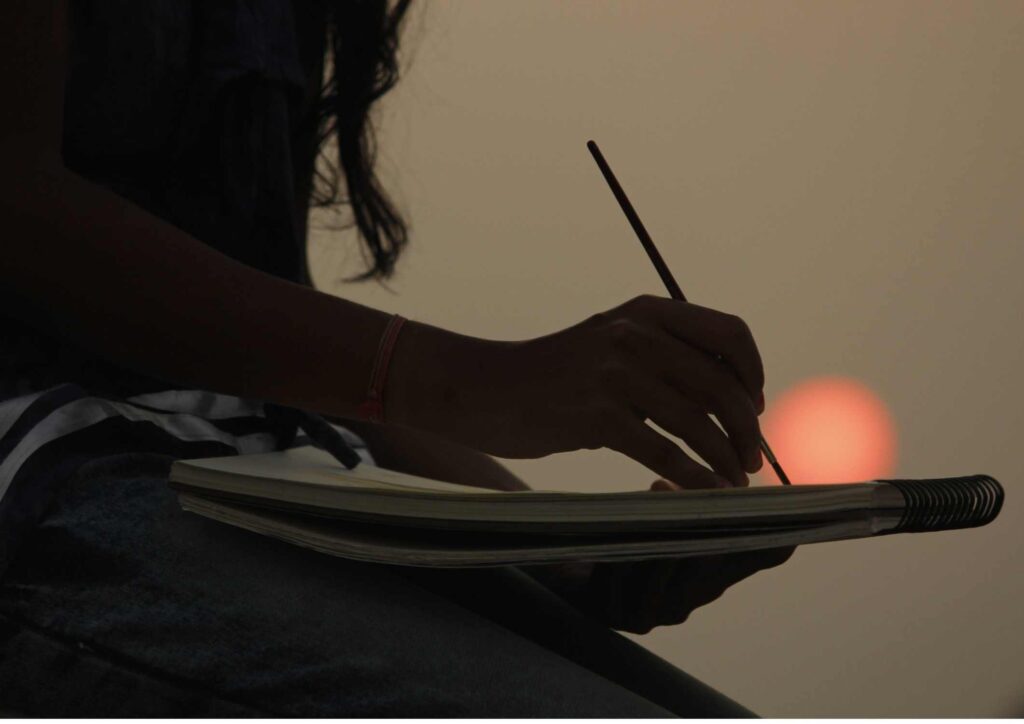
Starting to draw can be a very nerve-racking activity especially when you believe that you can’t draw. I have encountered so many people who really believe they can’t draw. This is a very self-limiting belief.
If you believe you can’t do something, well, then you can’t. However, the truth is, everyone can draw.
Yes, some people are born with an innate ability to render form and shape in a highly expressive or realistic manner. Just because you don’t have the same level of skill (yet), doesn’t mean you can’t get there!
I have taught many students over the years who came into my classroom believing they truly could not draw. The first step in helping someone to move through their anxiety around drawing is to get them to believe in their own potential.
We all have potential!
This is the most important step when learning how to draw. Believe that you can and that your skill will improve.
Don’t try to be perfect!

Try to focus on the drawing process. Perfectionism is the thief of creativity and often is the reason people don’t continue or even don’t start drawing.
The truth is drawing is like any other skill. If you want to learn how to start drawing – you have to be determined and practice, practice, and practice some more. Be gentle with yourself and keep at it every day.
[Related article: How to create the illusion of depth in art]
Drawing is about learning to See

Learning to draw is an interesting concept because it’s not about ‘learning to draw’, it’s about learning to SEE. In other words, we have to start really looking at our subject with new, fresh eyes.
Once you start looking at things as though you have never seen them before, then you start translating them into a drawing and the magic begins.
Looking closely at your subject matter while drawing gives you a far deeper understanding of the material world.
Observational drawing is the key to learning how to start drawing and improving your skills.
You don’t have to be an artist
This is a common misconception that you have to have some sort of innate talent in order to be able to draw. The truth is, anyone can learn how to draw – regardless of whether or not you consider yourself an ‘artist’.
Yes, it takes time and practice to get better at drawing, but if you are willing to put in the effort, you can definitely learn how to start drawing.
[Related article: How to Draw a Background]
Choose your subject matter

There is an infinite amount of subject matter you can choose from for your drawing. You can draw from your imagination, or from a real object, in real life. You also don’t have to stick to the classical subject matter – go ahead and start a unicorn drawing, or a giraffe drawing! Many established artist began by simply drawing cartoon characters!
A very good subject matter to start with is copying a drawing from a master artist like Da Vinci or Michelangelo. This exercise gives you a good understanding of the language or drawing and will give you insight into what and how the artist sees.
By looking at the master’s drawings, you get a good sense of how they use lines in their works and how they create shadows and textures.
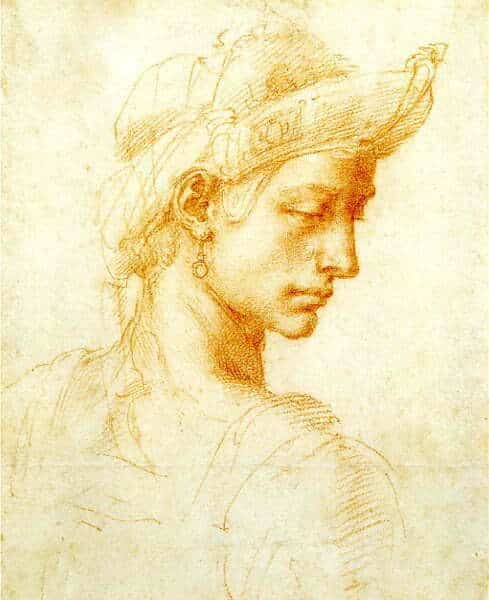

Da Vinci, Head of a Young Woman
I often find that drawing from real life can be very exciting. Take your sketchbook with you wherever you go and sometimes draw outdoors. Whether you are waiting in a queue or sitting on a bench you will find some lovely subject matter to inspire you.
If you are stuck on ideas you can follow an art challenge and get prompts to help inspire your drawings.
“Drawing is an incredibly therapeutic activity which has huge benefits in managing anxiety, stress, and depression. Whatever your reason is, it is an excellent way to start your creative journey..”
[Related: 101 Cool Designs to Draw]
Practice Shading techniques
There are many techniques that people use in drawing to create expressive lines or shadows.
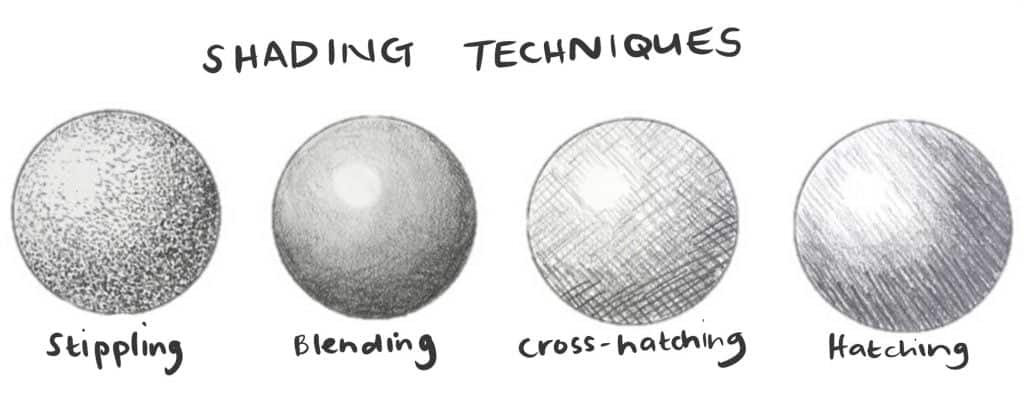
You might use the hatching or cross-hatching technique in your shadow areas of a building say for instance. Draw your lines closer together in order to create a darker, deeper shadow. To create a lighter effect, draw your lines further apart.
Blending/ grading is where people hold their pencil ‘flat’ on the page in order to create a smooth texture.
The more pressure you put on your pencil, the darker the shaded area is. This is often used to draw subject matter with a very smooth surface – like facial features or ceramics.
Stippling is a great technique that can be used to create highly detailed drawings. This technique tends to take up a lot of time, but the results are often beautiful.
Be careful when using the stippling technique when drawing faces – you don’t want it to look like your subject has a rash!
Scribbling is a fun way to create really expressive lines in your drawing. Start working in figure eights that overlap one another. The more they overlap the darker the shaded area will be. To create lighter areas, you loosen up your scribbling.
I have found the best way to use shading techniques is to find which combinations work well together. I often use a bit of blending combined with cross-hatching or stippling in order to give my drawings an expressive but structured feeling.
Once again, this also depends on the style you are going for.
Tip: Place a piece of paper between your hand and the drawing in order to prevent smudging your work!
Copy drawings and paintings when you are learning to draw

When starting out in any new skill it’s a good idea to copy the work of other artists. Practice will help you learn the proportions and techniques used by the artist.
It will also help train your eye to see what makes a good drawing.
You can copy any type of artwork including sketches, portraits, landscapes, or still lives.
When copying a work, be sure to study it closely. Look at how the artist uses shape, shadow, and line.
Take a drawing or art class

A great way to learn different drawing techniques and build your sketching skills is by taking a drawing or art class.
This will give you access to different resources and techniques that a professional artist might use.
Keeping a sketchbook
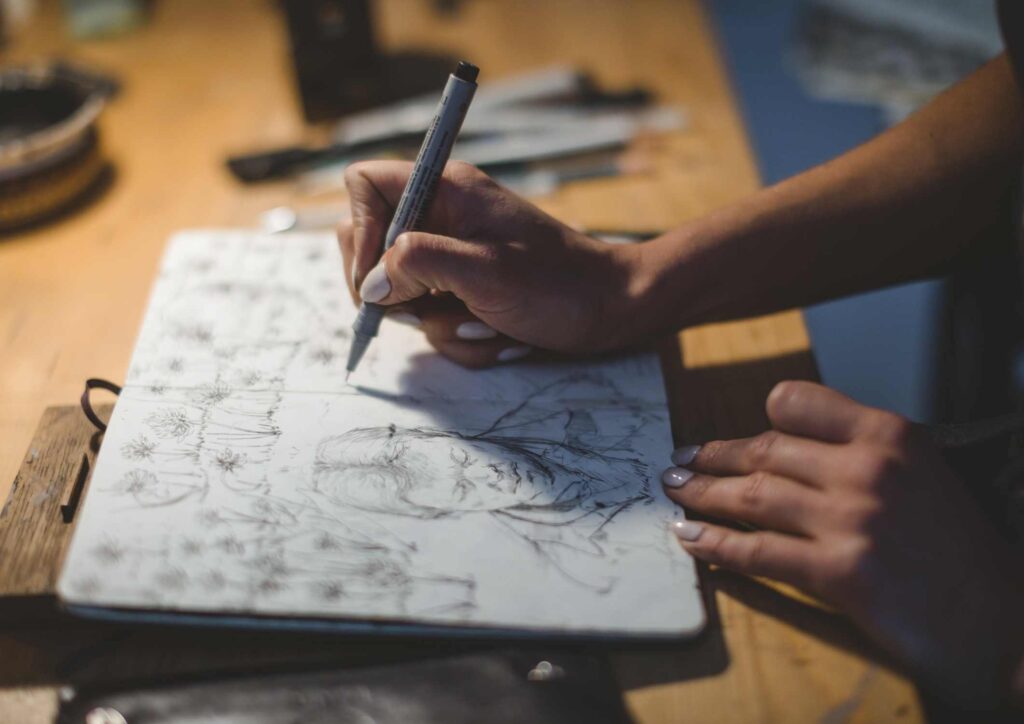
It’s a good idea to keep all your drawings and experimentation in a sketchbook – over time you can watch how you have explored and grown in your drawing skills.
As you learn and practice new techniques, be sure to keep track of your progress by sketching in a sketchbook.
Sketching out ideas, practicing shading, and copying other artists’ work can all be tracked in a sketchbook. This will help you see your progress over time and give you inspiration for future
You may even find that new ideas develop from the drawings you have already completed.
Related article: The Ultimate List of 50 Fun Things to Draw When Bored!
Make drawing a habit

To get better and improve your drawing you need to make it a habit.
That doesn’t mean you have to spend hours every day on it, but try to make it a regular creative outlet for you to build your sketching skills.
Experiment with different mediums
Explore and experiment with different mediums. This means you should draw lines with pencil, charcoal, ink, pen, pastel, coffee, and basically anything you can make a mark with.
Understand Value
Value is a term that refers to the lightness or darkness of an item. We can use value to give depth and perspective to a drawing. Shading a sphere is one of the most common ways we may practice value as artists!

Understand the Power of Color
Colour has a strong emotional impact on a drawing – bright and vivid, dark and somber, and so on. Color can be utilized to call attention to certain parts of the image by accentuating them.
Edges are important
Edges can provide a wealth of data about a subject. They can indicate the strength of a light source and where it is coming from, how clear the weather is, how essential the object is in the composition, whether the item is in focus or in the background, and how far away it is.
Understand Light and Shadow in Drawing
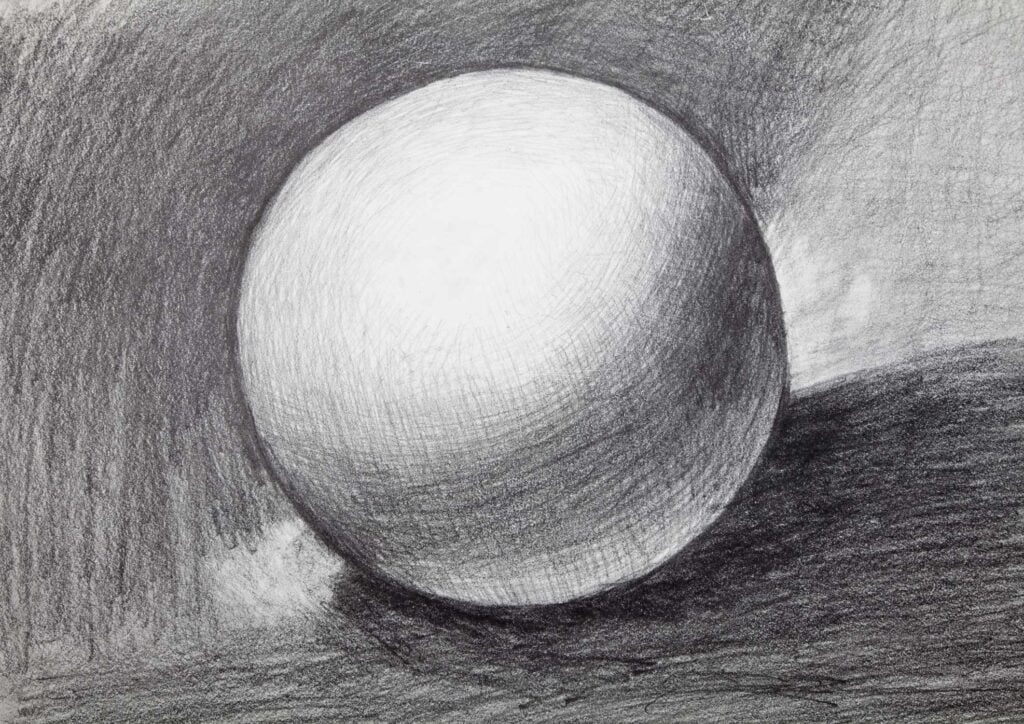
When it comes to shading, the use of light and dark can create an illusion of depth and volume. Understanding how light and shadow work is key in creating realistic drawings.
Practice Drawing Form
Form is the three-dimensional shape that an object takes and learning to see and draw form accurately is essential for realistic drawings.
By understanding form, you can create the illusion of depth and volume in your drawings.
Gesture drawing is a great way to improve your understanding of the human form and movement. Gesture drawing is the act of quickly sketching out the basic lines of a figure to capture its movement or posture.
Practice Drawing Proportions
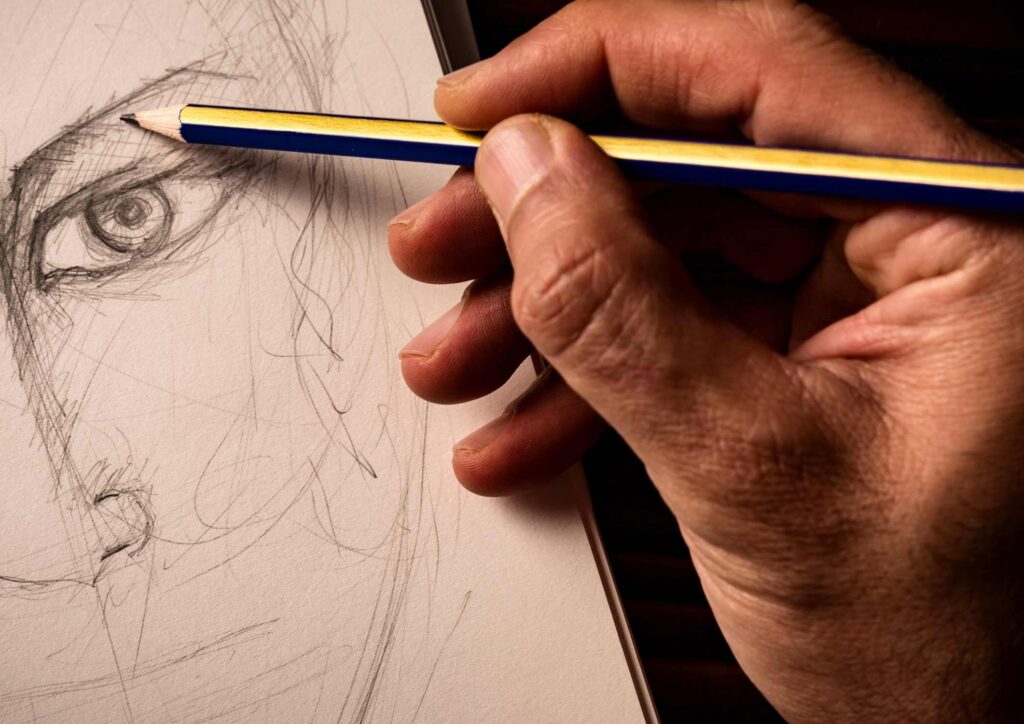
Incorrect proportions can make a drawing look amateurish. It’s important to practice accurately drawing the proportions of a subject in order to create a realistic and believable image.
Draw from Life
Take a drawing session outside! The best way to improve your drawing skills is by practicing from life. This means drawing simple objects, people, or scenes from nature that you see right in front of you.
Use a Photo Reference
Working from reference photos is undoubtedly the quickest way to improve your skills is by using a photo reference.
A photo reference is a photo of an object or scene that you use as a guide while drawing.
This will help you train your eye to see the details and nuances of an object and will give you a better understanding of light and shadow.
Understand Perspective Drawing
One of the most important aspects of creating realistic drawings is understanding perspective. Perspective drawing is the technique that helps us create a sense of depth in our images.
There are different types of perspective, but one of the most common is linear perspective. This is the kind that uses lines to create a sense of distance and recession.
Use Drawing exercises to warm up!
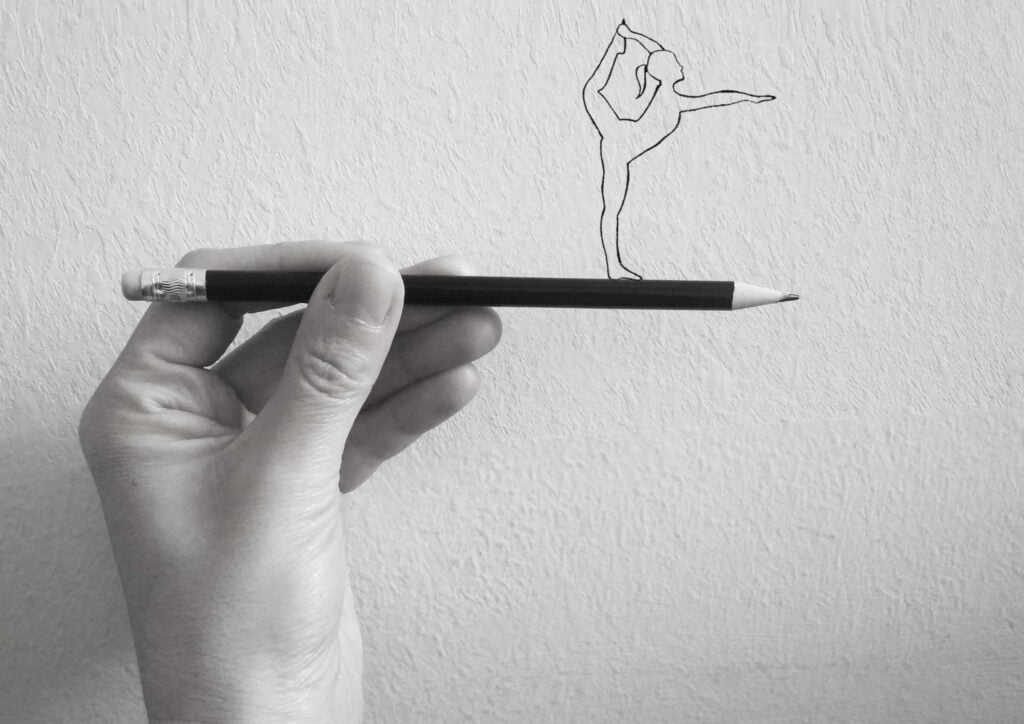
Drawing exercises to follow…
There are many different drawing exercises that you can try out to start warming up.
- A great exercise to try is drawing with your non-dominant hand.
- Turn your reference image upside down.
- Try to draw with your eyes closed.
- Fill a whole page with different lines of thickness.
- Draw stick figures
- Drawing cartoons
The goal of drawing exercises is to help you get a feel for making marks on the paper. It is important that you play and enjoy the learning process.
‘Drawing on the Right Side of the Brain’ by Betty Edwards is a fantastic book that has several drawing exercises for you to try. In fact, it is considered one of the best books on how to improve your drawing skills!
[Have a look at my curated list of the Best Drawing Books for Artists]
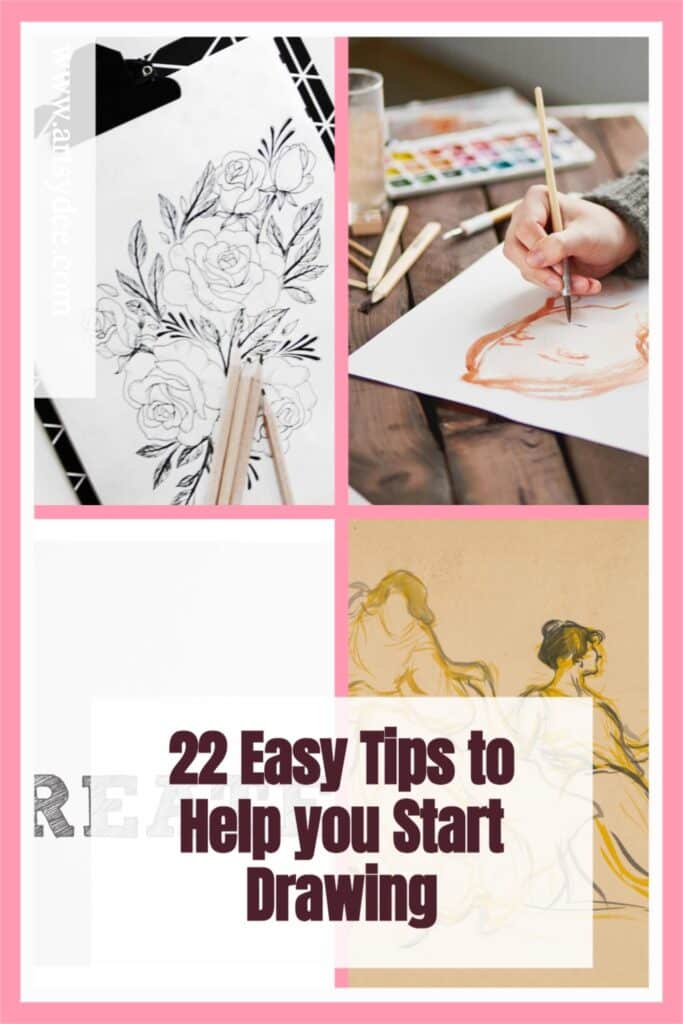
Essential Drawing Materials to Start Drawing
You can choose to draw with pencil, crayon, pastel, markers, or anything that makes a mark on a surface really. You can also choose to draw on anything from paper to cloth. This really depends on your preferences once again and it’s important that you experiment.
[Related: Anime Pose Reference]
It is a good idea to try out a variety of different materials in order to find ones that suit you and your style.
If you want an easy starting point then just start with a very simple range of supplies. You can do a wide range of drawing with just the basics.

Traditional materials for starting to draw:
- Three different pencil grades (usually HB, 2B, and 6-8B) The H grade is mostly only used for when you are starting to draw your outlines very lightly.
- Drawing/sketching paper or sketchbook.
- Soft rubber eraser
[Read my article on choosing the Best Drawing Erasers]
- Basic metallic sharpener
These are optional but are great to have as your drawing skills improve and you want to extend your techniques:
- Blending stumps or tortillons
- Kneaded eraser (this is an awesome tool that you can manipulate to get into smaller areas)
- Drawing board
Digital Drawing Tools

If you are a graphic designer, or just enjoy working with creative technology, it can be really easy to create a realistic drawing on your PC, laptop, tablet, or phone.
I enjoy drawing on my iPad using my Apple Pencil and Procreate. I love drawing digitally as well as traditionally!
Digital painting is similar to digital drawing, but with the use of more painterly mark-making.
I was surprised at how much drawing on my iPad felt like actual drawing and I absolutely love the feeling of it.
Explore Drawing styles
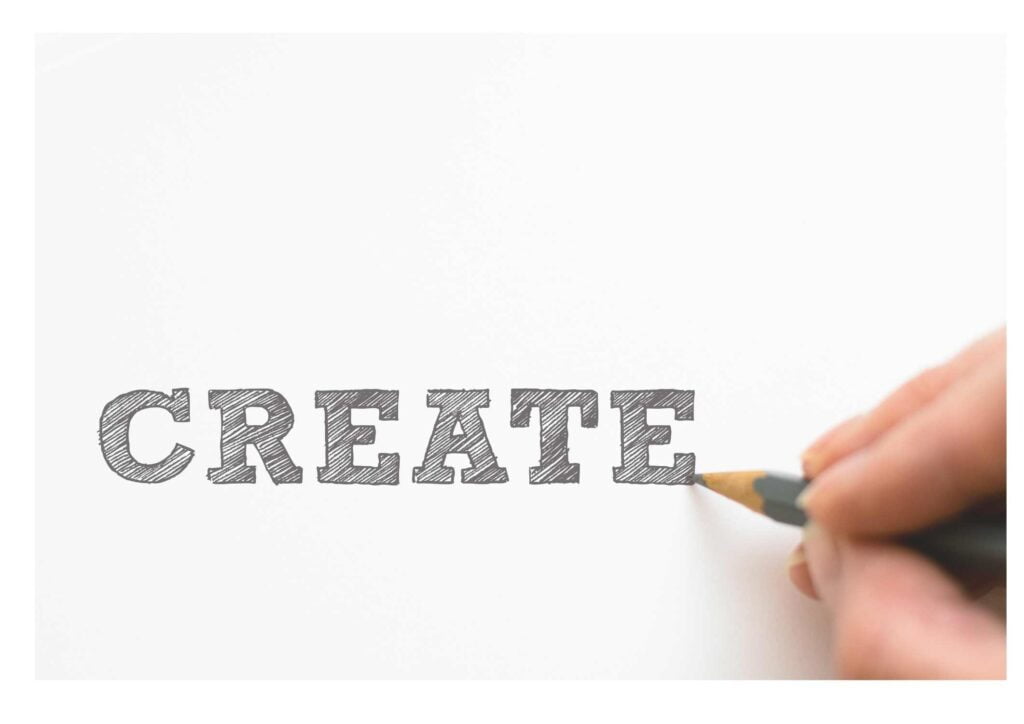
There are many different styles of drawing that you can try. If you have started drawing and have developed a personal style, a fun challenge is to choose a new drawing style to expand your sketching skills!
[Related article: How to Trace on Procreate in 11 Easy Steps!]
Line drawing or Contour Drawing
Line Drawing is literally just drawing your subject matter using line and no shading. You can use contour lines and outlines to define your shapes and forms. Artists often enjoy doodling using contour lines.
Abstract drawing
Abstract drawing is a style where you draw from your imagination. Your image is non-figurative, meaning that it doesn’t look like anything recognizable. Many people find this a very liberating type of drawing.
[Related article: 18 Texture Drawing Examples to Help You Get Inspired: How to Draw Texture]
Anime and Manga Drawing
Anime drawing is a style based on Japanese animation. It involves using black outlines, stylized shapes, and flat tones.
Photorealism
Photorealism is when an artist draws an image to such a height of realism that one might think it was a photo. Artists like Chuck Close use very mathematical methods in order to achieve this level of realism.
Expressive Drawing
Expressive drawing is using lines and tone to create emotionally expressive drawings. This style often involves movement or action of sorts.
Architectural Drawing
Architectural drawing is the technical drawing of a house or building using very straight lines and geometrical devices. The drawing must be able to be recreated in reality and so there must be a high level of accuracy.
Urban Sketching
Urban sketching is a form of drawing where an artist captures the scenery and objects of urban spaces in their sketches. They often work quite quickly and may include a pen and watercolor in their drawings.
Check out this video on how to start Urban Sketching…
[Related Article: 11 Tips on How to Improve Your Drawing!]
[Download your Free 30 Days of Drawing Ideas below ⬇ ]
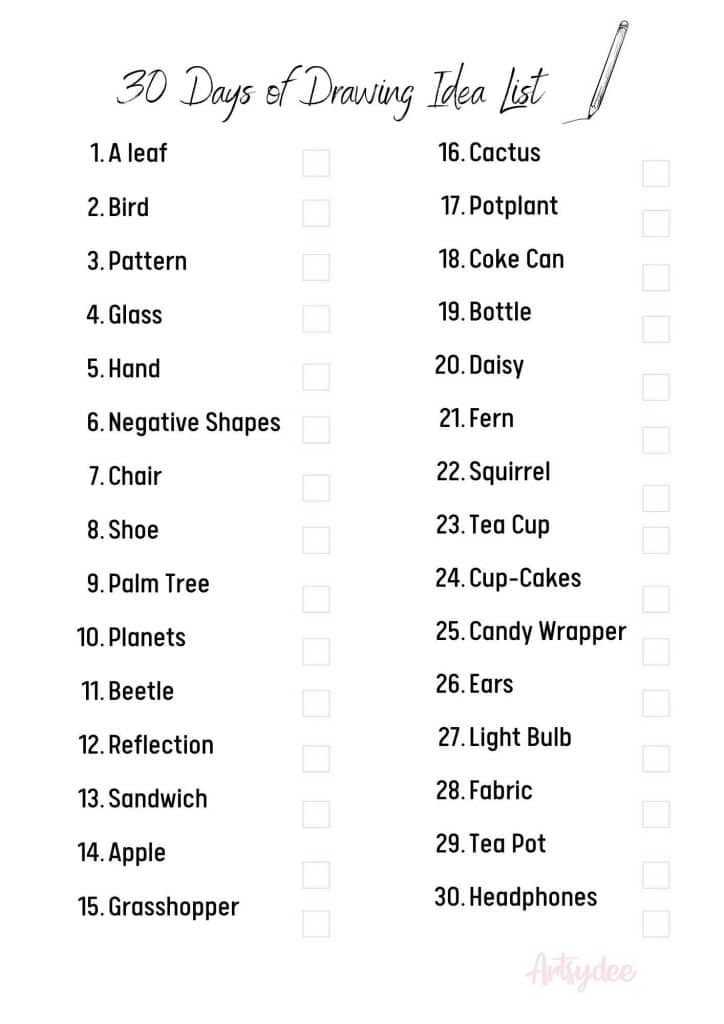
Frequently Asked Questions about How to Start Drawing…
Can I teach myself to draw?
Yes, you can definitely teach yourself how to draw. There are a number of great books and online resources that can help you get started.
How do I begin to draw?
Whichever way you want! You can start with line drawings, abstract drawings, anime drawings, or photorealistic drawings. It really depends on what you are interested in and what your level of skill is.
What are the 5 basics of drawing?
Understanding edges, spaces, light and shadow, relationships, and the whole, or gestalt, are the five components of drawing. When all five basic skills of drawing are combined, they form the elements of a completed artwork.
[Related article: 121 Fun and Easy Objects to Draw]
How can a beginner start art?
There are a lot of different ways that a beginner can start art. You can take an art class, join an art group, or find a mentor. Practicing regularly and keeping a sketchbook to track your progress is also important.

Conclusion
If you have been wondering how to start drawing, these 22 tips will help get you to get going. Remember to practice and experiment with different techniques to find what works best for you.
Draw from life whenever possible, and don’t be afraid to challenge yourself. The more you draw, the better you will become. What are you waiting for? Start sketching!
Other articles you may enjoy…
How to Improve Your Digital Creations | 22 Digital Painting Tips
Looking for things to draw on your hand? 50 Easy drawing ideas
Sitting Drawing Reference | 18 Free Poses to Help You with Figure Drawing
3 Simple Steps to Outline Drawing

Thank you so much for providing all these helpful tips and the guides, I can’t tell you how useful they have been for a complete beginner like myself! Your guides are really clear and easy to follow, and give great results – thanks again!
I am so glad to hear that you have found them helpful! Feel free to let me know if there is anything else you would like me to write about 🙂